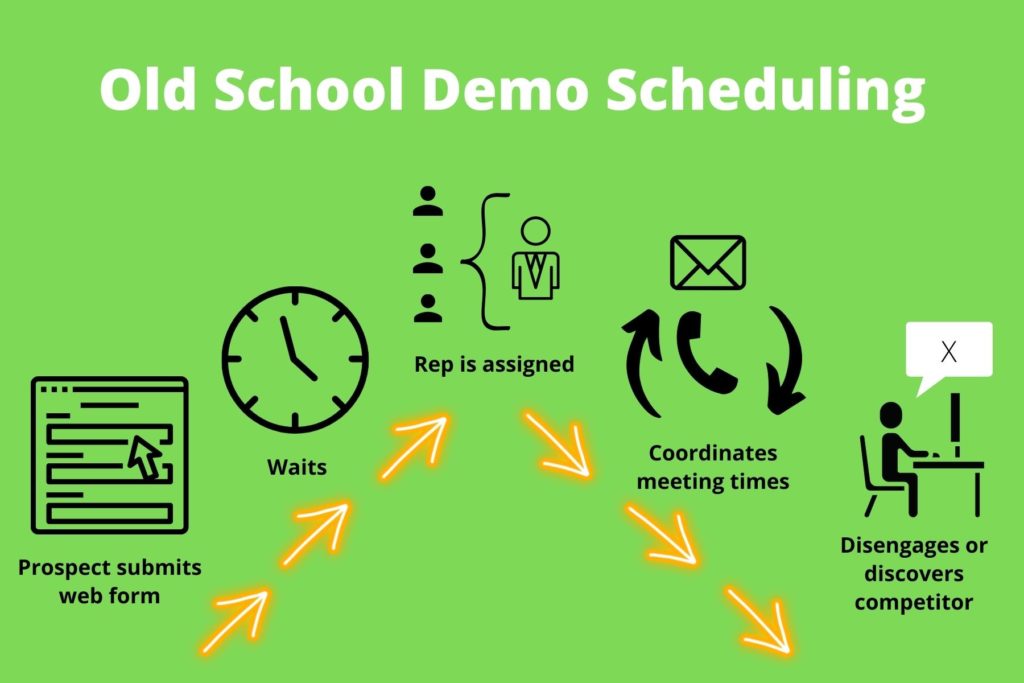While casually waiting curbside to pick up Smashburger for dinner, you scheduled a dentist appointment, reserved seats at a concert, and put some time on your boss’s calendar for a quick check-in — all through automated meeting scheduling.
No calls. No emails. You did it all on your phone without speaking to anyone. As a consumer, you prefer that kind of autonomy.
Likewise, today’s B2B buyers want to take a self-guided journey through your product. They expect immediacy. So why not reduce the friction and let them schedule their own meetings?
Avoiding Scheduling Ping Pong
Ping pong is a fun game when it’s played with paddles, a table, or Dude Perfect, but not with scheduling. Reaching out with emails and phone calls just to say, “Tag, you’re it,” is an outdated waste of time. And yet many B2B organizations still manually schedule demos, manually distribute leads, and manually lose prospects.

Scheduling demos several days after a request form has been submitted will almost always decrease your show rate. Drift, a conversation cloud company, tested the response time of 433 companies and found that only 7% responded in the first five minutes after a form submission. More than 50% didn’t respond within five business days.
Poor scheduling practices can unravel months of stellar marketing and sales efforts. If you’ve successfully prospected and qualified a buyer who’s a perfect fit for your solution, you certainly don’t want manual processes to be the bottleneck for closing deals.
Scheduling demos sooner sends a clear message that you want to solve the prospect’s problem immediately. It also gives prospects less time to lose interest.
An HBR analysis of 2,200+ companies found that those who attempted to reach leads within an hour were nearly seven times more likely to have meaningful conversations with decision makers than those who waited an hour.
There’s an easy solution to old school demo scheduling that doesn’t involve pressuring your employees to work harder, faster, or become online creepers.
Get the 411 on Automated Meeting Scheduling
Sales appointment scheduling software varies in capabilities but simply stated, some offer fully automated solutions and others are enhanced calendaring solutions.
Most calendaring solutions are calendar integrations that customize schedules and allow users to set scheduling rules. You’ll recognize calendaring software when you see the phrase “Click the link below to book some time on my calendar,” a request some consider a little aggressive.
Truly automated scheduling is a webform-to-meeting solution where the demo request and booking confirmation are combined into one seamless process, supporting a customer-centric buying journey.
For example, LeanData’s BookIt for Forms will ingest prospects from a webform on your website, qualify the prospects, route based on certain logic to the appropriate rep, and present prospects with potential meeting times to schedule on the spot.
Automated Meeting Scheduling Gives Buyers Control of the Calendar
Software demos are not nearly as entertaining as Southwest safety demonstrations, so if a prospect is intrigued enough to fill out a demo request form, the meeting scheduling process ought to be a snap. It’s an opportunity to make a great first impression with your prospect.
Plus, if your company wants to scale (can I get an amen?), automation is your fuel.
John Hall, contributor to Forbes, writes, “With automation delivered by modern digital technology, everybody wins. Customers benefit from faster turnaround. Companies benefit from higher sales-force productivity…Freed from the manual weight of doing business, companies can scale growth exponentially with limited to no increase in headcount.”
Automated meeting scheduling puts today’s digital-first buyers in the driver’s seat, right where they want to be.











